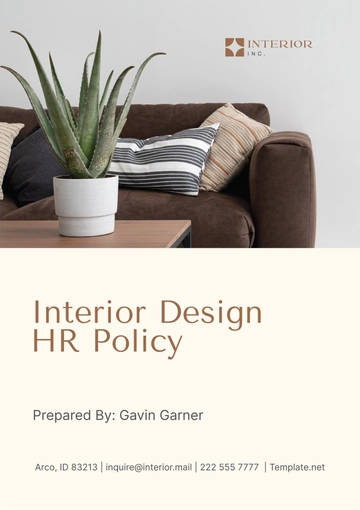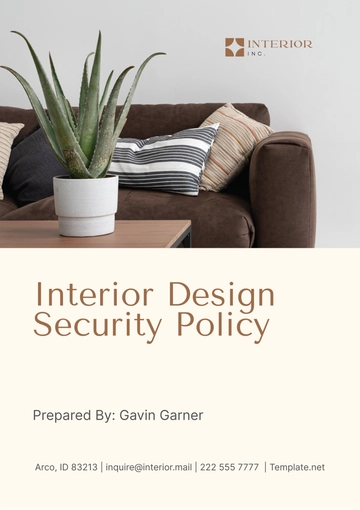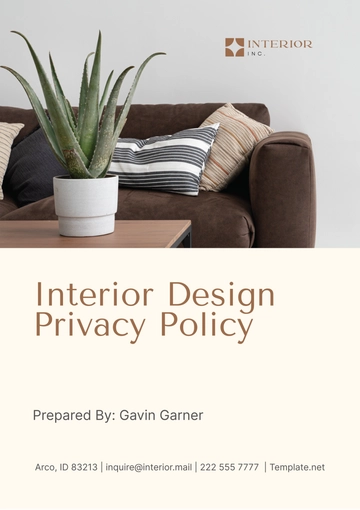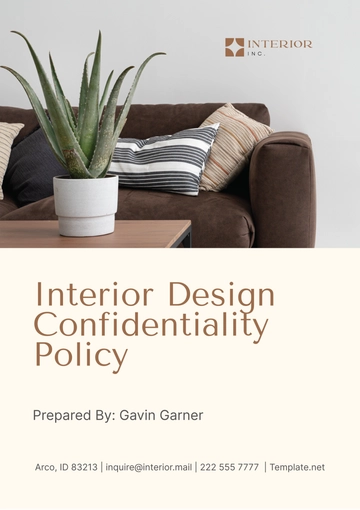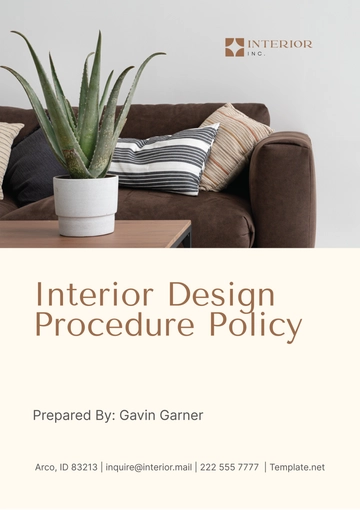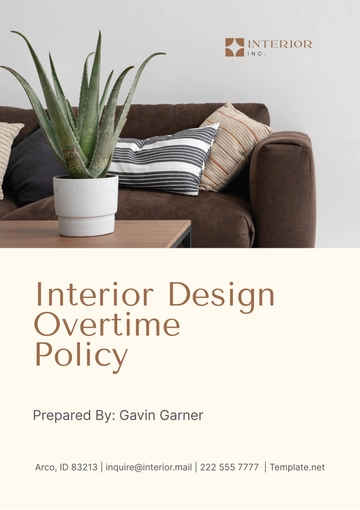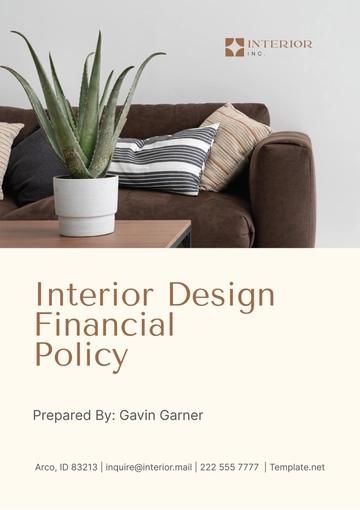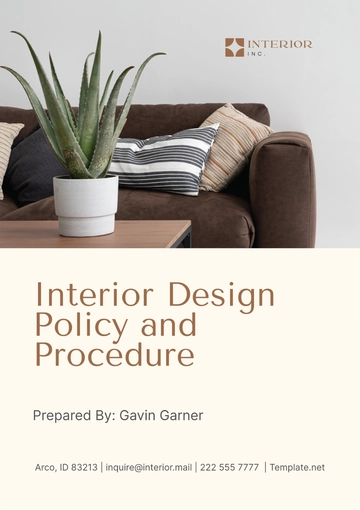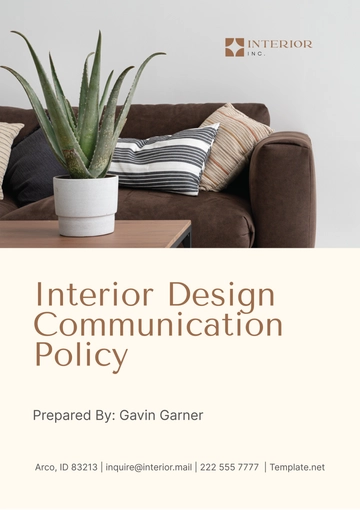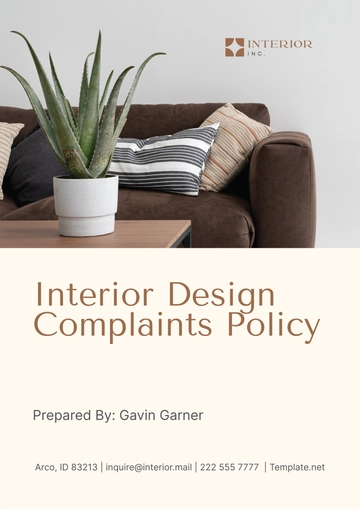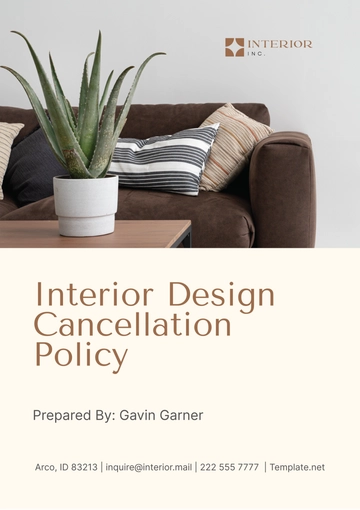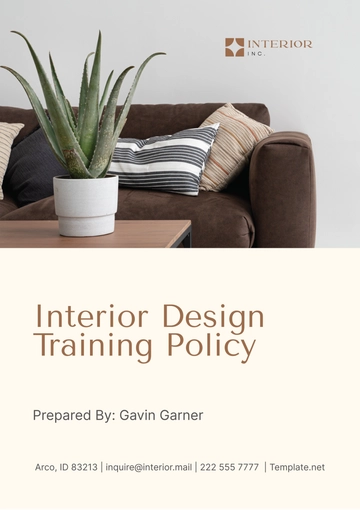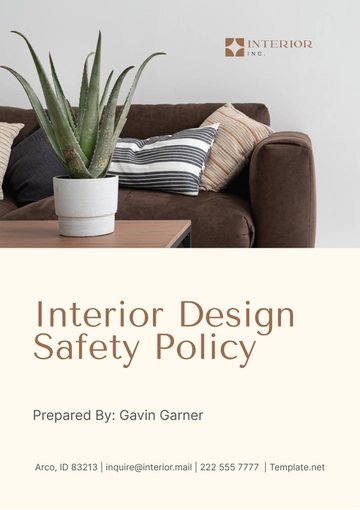Free Interior Design Procurement Policy

I. Introduction
A. Purpose of the Policy
The Interior Design Procurement Policy is established to ensure the efficient and transparent procurement of goods and services necessary for interior design projects undertaken by [Your Company Name]. This policy aims to promote fairness, integrity, and accountability in the procurement process while supporting the organization's goals of delivering high-quality interior design solutions within budget and schedule constraints. It also serves to standardize procurement practices across the organization and provide guidance to staff involved in procurement activities.
B. Scope and Applicability
This policy applies to all procurement activities related to interior design projects conducted by [Your Company Name], including the sourcing and acquisition of materials, furniture, fixtures, and equipment (FF&E), as well as the selection and management of vendors and contracts. It applies to all staff members involved in procurement activities, including interior designers, project managers, procurement officers, and senior management.
C. Definitions of Key Terms
In this policy, procurement refers to the process of acquiring goods and services needed for interior design projects. A vendor is defined as an individual or entity supplying goods or services to [Your Company Name] for interior design projects. A contract is a legally binding agreement between [Your Company Name] and a vendor for the provision of goods or services, outlining terms, conditions, and responsibilities.
II. Governance and Authority
A. Responsibilities of Stakeholders
The Interior Design Procurement Policy assigns clear roles and responsibilities to stakeholders involved in the procurement process, including interior designers, procurement managers, project managers, legal counsel, and senior management, to ensure effective oversight and coordination. Interior designers are responsible for identifying procurement needs and specifications, while procurement managers oversee the sourcing, selection, and contracting processes in compliance with organizational policies and procedures.
B. Approval Authority for Procurement Activities
All procurement activities, including vendor selection, contracting, and budget approval, require authorization from designated approvers in accordance with established delegation of authority guidelines. Approval authority is delegated based on the complexity and value of the procurement, with clear escalation paths for approvals beyond delegated authority levels to ensure accountability and compliance.
C. Delegation of Authority
Delegated authority for procurement activities is based on the complexity and value of the procurement, with clear escalation paths for approvals beyond delegated authority levels. Interior designers and project managers may be delegated authority for routine procurement activities within predefined thresholds, while higher-value procurements require approval from senior management or designated committees to ensure proper oversight and control.
III. Procurement Planning
A. Project Initiation and Planning
Interior design projects undergo comprehensive initiation and planning phases, including needs assessment, stakeholder engagement, and development of procurement plans aligned with project objectives and timelines. Project initiation involves defining project scope, objectives, and deliverables, while planning encompasses resource allocation, risk assessment, and procurement strategy development to ensure project success.
B. Budget Allocation and Approval Process
Budgets for interior design projects are allocated and approved based on thorough cost estimation and justification, with regular monitoring and reporting on budget utilization throughout the project lifecycle. Budget allocation involves forecasting project costs, including design fees, materials, labor, and contingencies, and obtaining approval from relevant stakeholders to ensure adequate funding for project execution.
C. Identification of Procurement Needs
The procurement team collaborates with interior designers and project stakeholders to identify and prioritize procurement needs, considering factors such as project scope, design requirements, quality standards, and budget constraints. Procurement needs are identified based on project specifications, including FF&E requirements, finishes, fixtures, and equipment, to support the design vision and functional requirements of the space.
D. Timelines and Milestones
Procurement plans include clear timelines and milestones for each procurement activity, ensuring timely delivery of goods and services to support the project schedule. Timelines are established based on project milestones, critical path activities, and lead times for procurement, with built-in buffers to accommodate potential delays and ensure project milestones are met.
IV. Vendor Selection and Evaluation
A. Criteria for Vendor Selection
Vendors are selected based on predetermined criteria, including experience, reputation, financial stability, compliance with regulatory requirements, and alignment with project goals and values. Additional criteria may include technical capabilities, capacity to meet project deadlines, past performance, and sustainability practices to ensure vendors meet project requirements and contribute to project success.
B. Prequalification of Vendors
Prior to engaging in formal procurement processes, vendors may undergo prequalification assessments to ensure they meet minimum eligibility criteria and standards set by [Your Company Name]. Prequalification criteria may include financial stability, technical capabilities, insurance coverage, safety records, and compliance with ethical and environmental standards to ensure vendors are qualified and capable of meeting project requirements.
C. Request for Proposals (RFPs) and Bidding Process
The procurement team prepares and issues RFPs or invitations to bid, providing vendors with detailed specifications, evaluation criteria, and submission instructions. RFPs outline project requirements, scope of work, evaluation criteria, and contractual terms to solicit competitive proposals from qualified vendors and facilitate objective evaluation and selection processes.
D. Evaluation Criteria and Scoring Mechanisms
Vendor proposals are evaluated objectively against predetermined evaluation criteria, with scoring mechanisms to facilitate transparent and consistent decision-making. Evaluation criteria may include technical capabilities, price competitiveness, quality of goods and services, past performance, compliance with contractual requirements, and alignment with project objectives to ensure the selection of the most qualified vendors.
E. Vendor Performance Evaluation and Monitoring
Performance of selected vendors is monitored throughout the project lifecycle, with regular evaluations based on criteria such as quality, timeliness, responsiveness, and adherence to contractual obligations. Performance evaluations provide feedback to vendors, identify areas for improvement, and inform future vendor selection decisions to maintain high standards of quality and service delivery.
V. Sourcing and Contracting
A. Sourcing of Materials, Furniture, Fixtures, and Equipment (FF&E)
The procurement team collaborates with interior designers and project stakeholders to source materials, furniture, fixtures, and equipment that meet project specifications, design requirements, and quality standards. Sourcing activities involve researching suppliers, obtaining quotes, and conducting supplier evaluations to identify vendors that offer products that align with project objectives and budget constraints.
B. Negotiation and Drafting of Contracts
Contracts are negotiated and drafted to formalize agreements with selected vendors, outlining terms and conditions, deliverables, pricing, payment terms, warranties, and dispute resolution mechanisms. Contract negotiations involve discussions on pricing, scope of work, timelines, and other contractual terms to ensure mutual understanding and agreement between [Your Company Name] and the vendor.
C. Terms and Conditions of Contracts
Contracts include clear and comprehensive terms and conditions that govern the rights and obligations of both [Your Company Name] and the vendor. Standard contract clauses address issues such as scope of work, specifications, delivery schedules, payment terms, indemnification, intellectual property rights, termination, and dispute resolution to mitigate risks and ensure compliance with legal and regulatory requirements.
D. Compliance with Legal and Regulatory Requirements
Contracts are reviewed to ensure compliance with relevant laws, regulations, and industry standards, including procurement regulations, contract law, intellectual property rights, labor laws, and environmental regulations. Legal counsel may provide guidance on contract compliance and assist in resolving legal issues to protect the interests of [Your Company Name] and mitigate potential liabilities.
E. Contract Management and Administration
Contracts are managed and administered throughout the project lifecycle to ensure compliance with contractual obligations, monitor vendor performance, and address any deviations or changes to the contract terms. Contract management activities include document control, change management, invoice processing, performance monitoring, and contract closeout to facilitate effective vendor management and project execution.
VI. Budgeting and Cost Control
A. Cost Estimation and Forecasting
Interior design projects undergo detailed cost estimation and forecasting to accurately determine project budgets and resource requirements. This involves assessing costs associated with design services, materials, labor, and other project expenses, taking into account factors such as inflation, market trends, and project complexities.
B. Cost Management Strategies
Cost management strategies are implemented to optimize project expenditures and ensure alignment with approved budgets. This may include value engineering, cost-benefit analysis, procurement bundling, and negotiation of favorable pricing terms with vendors to maximize cost savings without compromising quality or project objectives.
C. Change Order Procedures
Change order procedures are established to manage changes to project scope, specifications, or deliverables that may impact project costs. Change orders require formal approval and documentation, with procedures in place to assess the impact on project budgets, timelines, and resources before implementation.
D. Cost Tracking and Reporting
Cost tracking systems are utilized to monitor project expenditures and compare actual costs against budgeted amounts. Regular cost reports are generated and shared with project stakeholders to provide visibility into project finances, identify variances, and facilitate informed decision-making to control costs and mitigate financial risks.
VII. Quality Assurance and Control
A. Standards and Specifications for Procured Goods and Services
Quality standards and specifications are established for procured goods and services to ensure they meet project requirements, industry standards, and regulatory requirements. This includes defining quality criteria, performance metrics, and acceptance criteria for evaluating the quality of delivered products and services.
B. Quality Control Inspections and Testing
Quality control inspections and testing are conducted to verify the quality and performance of procured goods and services. This may involve on-site inspections, product testing, and quality audits to identify defects, non-conformities, and deviations from specifications and initiate corrective actions to address quality issues.
C. Warranty and Maintenance Requirements
Procured goods and services are required to meet warranty and maintenance requirements specified in contracts to ensure long-term performance and durability. Warranty provisions outline the vendor's obligations for repairing or replacing defective products or providing maintenance services within the warranty period to minimize disruptions and costs associated with warranty claims.
D. Non-Conformance and Corrective Actions
Procedures are established to address non-conformance and implement corrective actions when procured goods or services fail to meet quality standards or contractual requirements. This may involve documenting non-conformities, investigating root causes, implementing corrective actions, and verifying effectiveness to prevent recurrence and improve overall quality performance.
VIII. Ethical Considerations
A. Avoidance of Conflicts of Interest
[Your Company Name] is committed to avoiding conflicts of interest in procurement activities to ensure fairness, impartiality, and integrity. Staff members involved in procurement are required to disclose any potential conflicts of interest and recuse themselves from decision-making processes where a conflict exists to maintain trust and credibility in the procurement process.
B. Promotion of Diversity and Inclusion
[Your Company Name] promotes diversity and inclusion in procurement practices to foster a diverse supplier base and support underrepresented groups in accessing procurement opportunities. Efforts are made to identify and engage with minority-owned, women-owned, and small businesses to promote economic empowerment and diversity in the supply chain.
C. Compliance with Anti-Corruption Laws and Policies
[Your Company Name] complies with anti-corruption laws and policies prohibiting bribery, kickbacks, and other corrupt practices in procurement activities. Staff members are trained on anti-corruption policies and procedures, and measures are in place to prevent, detect, and report any instances of bribery or corruption to uphold ethical standards and legal obligations.
D. Confidentiality and Data Protection
[Your Company Name] maintains confidentiality and protects sensitive information obtained during procurement activities, including vendor proposals, pricing information, and contract negotiations. Access to confidential procurement data is restricted to authorized personnel, and measures are implemented to safeguard data integrity, confidentiality, and privacy in compliance with data protection laws and policies.
IX. Documentation and Recordkeeping
A. Documentation Requirements for Procurement Activities
Comprehensive documentation is maintained for all procurement activities, including records of purchases, contracts, bids, proposals, correspondence, and approvals. This documentation provides a clear audit trail of procurement decisions, transactions, and communications, ensuring transparency, accountability, and compliance with organizational policies and regulatory requirements.
B. Records Retention and Archiving
Procurement records are retained and archived in accordance with established records retention schedules and legal requirements. Records are securely stored in electronic or physical formats, with appropriate controls in place to prevent loss, unauthorized access, or tampering, and to facilitate timely retrieval and disposal in compliance with retention policies.
C. Access to Procurement Records
Access to procurement records is restricted to authorized personnel with a legitimate business need, such as procurement officers, project managers, auditors, and legal counsel. Access controls, user permissions, and authentication mechanisms are implemented to safeguard sensitive procurement information and prevent unauthorized disclosure or misuse.
D. Compliance with Document Management Policies
Procurement records are managed and controlled in accordance with [Your Company Name]'s document management policies and procedures. This includes standardized naming conventions, version control, metadata tagging, and document classification to ensure consistency, accuracy, and accessibility of procurement records across the organization.
X. Risk Management
A. Identification of Procurement Risks
Procurement risks are identified through comprehensive risk assessments, considering factors such as market volatility, vendor reliability, supply chain disruptions, regulatory changes, and project complexities. Risk registers are maintained to document and prioritize procurement risks based on their likelihood and potential impact on project objectives and timelines.
B. Risk Assessment and Mitigation Strategies
Risk assessments are conducted to evaluate the likelihood and potential impact of procurement risks and develop mitigation strategies to minimize their impact on project outcomes. Mitigation strategies may include risk avoidance, risk transfer, risk reduction, and risk acceptance, tailored to address specific procurement risks and enhance project resilience.
C. Contingency Planning
Contingency plans are developed to mitigate the impact of unforeseen events or disruptions on procurement activities and project delivery. Contingency measures may include alternative sourcing options, emergency procurement procedures, supply chain diversification, and business continuity plans to ensure continuity of operations and minimize project delays or disruptions.
D. Insurance Coverage for Procurement Activities
[Your Company Name] maintains appropriate insurance coverage to mitigate financial risks associated with procurement activities, including liability insurance, professional indemnity insurance, and project-specific insurance policies. Insurance coverage is reviewed regularly to ensure it aligns with project requirements and provides adequate protection against potential liabilities and losses arising from procurement activities.
XI. Training and Awareness
A. Training Programs for Procurement Personnel
[Your Company Name] provides training programs and resources to equip procurement personnel with the knowledge, skills, and competencies required to perform their roles effectively and in compliance with organizational policies and procedures. Training topics may include procurement regulations, contract management, ethical procurement practices, risk management, and data protection.
B. Awareness Campaigns on Procurement Policies and Procedures
Awareness campaigns are conducted to educate stakeholders across the organization on procurement policies, procedures, and best practices. These campaigns may include workshops, seminars, newsletters, intranet resources, and other communication channels to promote understanding and adherence to procurement guidelines and foster a culture of compliance and accountability.
C. Continuous Improvement Initiatives
[Your Company Name] continuously reviews and enhances its procurement training programs and awareness campaigns to reflect evolving best practices, regulatory requirements, and organizational needs. Feedback from stakeholders is solicited to identify areas for improvement and implement targeted interventions to enhance procurement effectiveness, efficiency, and compliance.
XII. Policy Review and Updates
A. Frequency of Policy Review
The Interior Design Procurement Policy is reviewed periodically to ensure it remains current, relevant, and effective in achieving its objectives. Reviews are conducted at least annually or as needed in response to changes in organizational priorities, regulatory requirements, or industry standards that may impact procurement practices.
B. Process for Policy Updates and Amendments
Updates and amendments to the Interior Design Procurement Policy are proposed by designated stakeholders, reviewed by procurement and legal teams, and approved by senior management or governing bodies. Changes are communicated to relevant stakeholders and incorporated into procurement processes and documentation to ensure alignment with updated policy requirements.
C. Communication of Policy Changes
Policy changes and updates are communicated to all affected stakeholders through official channels, such as memos, emails, intranet announcements, and training sessions. Stakeholders are informed of the rationale for policy changes, their implications for procurement activities, and any actions required to ensure compliance with revised policy requirements.
XIII. Compliance and Enforcement
A. Compliance Monitoring and Auditing
Compliance with the Interior Design Procurement Policy is monitored through regular audits, reviews, and inspections conducted by internal or external auditors. Audits assess adherence to policy requirements, identify non-compliance issues, and recommend corrective actions to address deficiencies and improve procurement practices.
B. Consequences of Non-Compliance
Non-compliance with the Interior Design Procurement Policy may result in disciplinary actions, including warnings, reprimands, suspension, or termination of employment, depending on the severity and frequency of violations. Sanctions are applied consistently and proportionally to ensure accountability and deter future instances of non-compliance.
C. Reporting Mechanisms for Policy Violations
Reporting mechanisms are established to facilitate the reporting of suspected policy violations or unethical conduct related to procurement activities. Whistleblower hotlines, anonymous reporting channels, and grievance procedures provide avenues for stakeholders to raise concerns, seek advice, or report allegations of misconduct confidentially and without fear of retaliation.
XIV. Conclusion
A. Acknowledgment of Stakeholder Commitment
[Your Company Name] acknowledges the commitment and cooperation of stakeholders in upholding the principles and requirements of the Interior Design Procurement Policy. The collective efforts of staff members, management, vendors, and other stakeholders contribute to the successful implementation of procurement processes that support organizational goals and objectives.
B. Continuous Improvement and Adaptation
[Your Company Name] is committed to continuous improvement and adaptation of its procurement policies and practices to address changing needs, emerging trends, and lessons learned from experience. Feedback from stakeholders, performance reviews, and benchmarking against industry standards are used to identify areas for improvement and implement enhancements to procurement processes and procedures.
C. Contact Information for Policy Queries or Feedback
For inquiries, clarifications, or feedback regarding the Interior Design Procurement Policy, stakeholders are encouraged to contact the procurement department or designated policy administrators. Contact information, including email addresses, phone numbers, and office locations, is provided to facilitate communication and support stakeholders in understanding and complying with policy requirements.
- 100% Customizable, free editor
- Access 1 Million+ Templates, photo’s & graphics
- Download or share as a template
- Click and replace photos, graphics, text, backgrounds
- Resize, crop, AI write & more
- Access advanced editor
Enhance your interior design procurement process with the Interior Design Procurement Policy Template from Template.net. This editable and customizable template is equipped with an AI Editor Tool, allowing you to tailor policies to your organization's needs. Streamline vendor selection, budgeting, and contract management with this comprehensive template for efficient and transparent procurement practices.
You may also like
- HR Policy
- Restaurant Policy
- Company Policy
- Accounting Policies and Procedures
- Website Policy
- Privacy Policy
- Safety Policy
- School Policy
- IT and Software Policy
- Law Firm Policy
- Construction Policy
- Interior Design Policy
- Travel Agency Policy
- Education Academic Policy
- Security Policy
- Real Estate Policy
- Expense Policy
- Software Policy

